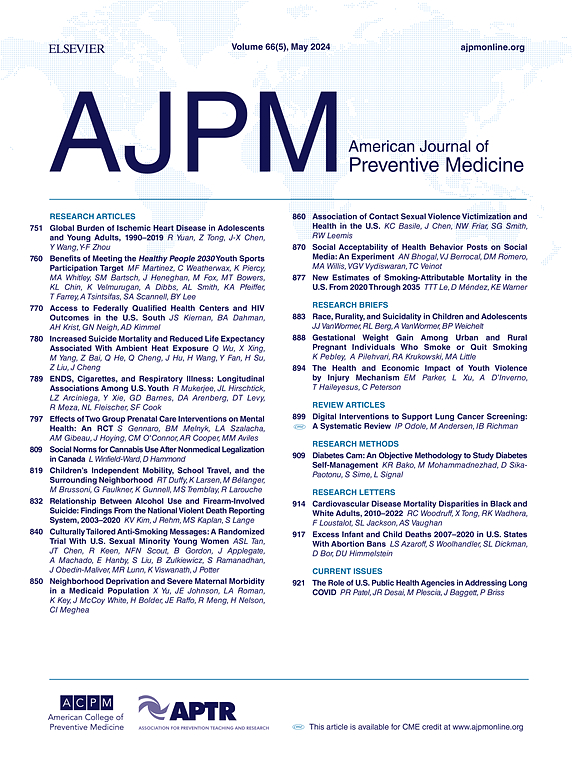极端风险保护令对枪支死亡的影响。
IF 4.3
2区 医学
Q1 MEDICINE, GENERAL & INTERNAL
引用次数: 0
摘要
导论:尽管越来越多的州实施了极端风险保护令(ERPOs)来遏制枪支暴力,但现有的ERPOs研究范围有限,主要集中在少数几个州,而且往往缺乏可靠的方法来确定其影响。在这项工作中,我们估计了ERPO编纂对枪支死亡(他杀和自杀)的影响。此外,我们还研究了种族亚群和那些可以申请此类限制的人(即执法人员、家庭成员、医疗保健专业人员)死亡人数的异质性。方法:采用差异中的差异方法,我们估计了实施ERPOs的19个接受治疗的州和哥伦比亚特区以及31个对照州的结果变化。样本从1998年到2020年,包括288,250起凶杀案和450,956起涉及枪支的自杀案。数据来自国家卫生统计中心(NCHS)的死亡证明。结果:授权卫生专业请愿者显著降低了总体自杀率,在白人受害者中最为显著(-14.79% [95% CI, -19.18%至-10.24%],年净效应为7 ~ 16)。包括家庭成员作为上访者,总体上显著减少了凶杀案,在大多数模式中,黑人受害者在不同程度上表现得最为明显。结论:结果表明,在上访者和亚人群中,实施ERPO对枪支相关杀人和自杀的效果存在显著差异。我们的研究强调了多元化上访者的好处,以及他们在结束不同社区暴力方面的作用。本文章由计算机程序翻译,如有差异,请以英文原文为准。
The Impact of Extreme Risk Protective Orders on Firearm Fatalities
Introduction
Although a growing number of states have implemented extreme risk protective orders to curb gun violence, existing studies on extreme risk protective orders have been limited in scope, focusing on a few states, and often lacking robust methodologies to identify their effects. This work estimates the effect of extreme risk protective order codification on firearm fatalities (homicides and suicides). Further, the study examines heterogeneity in fatalities across racial subpopulations and those who can petition for such restrictions (viz. law enforcement, family members, healthcare professionals).
Methods
Using a difference in difference approach, the authors estimate changes in outcomes across 19 treated states and the District of Columbia, which implemented ERPOs, and 31 control states. The sample runs from 1998 to 2020, including 288,250 homicides and 450,956 suicides involving firearms. Data are drawn from National Center for Health Statistics death certificates.
Results
Empowering health professional petitioners significantly reduces suicides overall, most prominently among White victims (−14.79%; 95% CI= −19.18%, −10.24%]; 7–16 state yearly net effect). Including family members as petitioners significantly decreases homicides overall, and most prominently among Black victims to varying degrees in most models.
Conclusions
Results indicate significant differences in the efficacy of extreme risk protection orders implementation on firearm-related homicides and suicides across petitioners and subpopulations. This study underscores the benefits of diversified petitioners and their role in ending violence across different communities.
求助全文
通过发布文献求助,成功后即可免费获取论文全文。
去求助
来源期刊

American Journal of Preventive Medicine
医学-公共卫生、环境卫生与职业卫生
CiteScore
8.60
自引率
1.80%
发文量
395
审稿时长
32 days
期刊介绍:
The American Journal of Preventive Medicine is the official journal of the American College of Preventive Medicine and the Association for Prevention Teaching and Research. It publishes articles in the areas of prevention research, teaching, practice and policy. Original research is published on interventions aimed at the prevention of chronic and acute disease and the promotion of individual and community health.
Of particular emphasis are papers that address the primary and secondary prevention of important clinical, behavioral and public health issues such as injury and violence, infectious disease, women''s health, smoking, sedentary behaviors and physical activity, nutrition, diabetes, obesity, and substance use disorders. Papers also address educational initiatives aimed at improving the ability of health professionals to provide effective clinical prevention and public health services. Papers on health services research pertinent to prevention and public health are also published. The journal also publishes official policy statements from the two co-sponsoring organizations, review articles, media reviews, and editorials. Finally, the journal periodically publishes supplements and special theme issues devoted to areas of current interest to the prevention community.
 求助内容:
求助内容: 应助结果提醒方式:
应助结果提醒方式:


